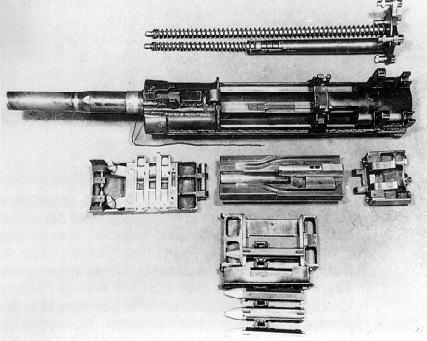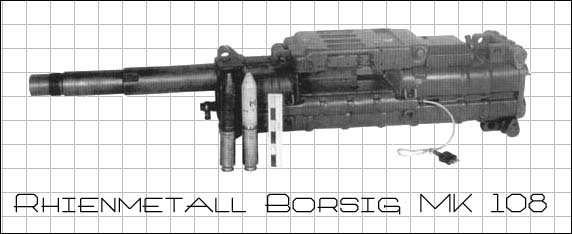LUFTWAFFE RESOURCE CENTER > ARMAMENTS > PREVIOUS PAGE

|
Manufacturer: Rhienmetall Borsig Designed: 1940 Produced: 1943-1945 Caliber: 30mm Cartridge: 30x90RB mm steel casing Action: Gas blowback |
Weight: 58 kg (127.9 lbs) Length: 1057 mm (3 ft 6 in) Barrel length: 23 inches (580 mm) Muzzle Velocity: 1770fps/540mps Rate Of Fire: ~650 Rounds per minute Round Types: High Explosive and Incendiary Round Weights: 330 gr. (11oz.) |
Construction:
This cannon was relatively lightweight, compact and proved to be an effective and reliable weapon. The simple construction as well as using nearly 80% stamped metal parts made the Mk 108 easy to manufacture. By using as few moving parts as possible made for easy maintenance and the electrical priming made the cannon ideal for aircraft installations. Disadvantages
Normally, gas-operated or delayed-blowback mechanisms are used in automatic weapons of rifle-calibre and larger because the chamber pressure in such weapons would be very high. Therefore, if a simple blowback system (where there is no positive lock between the bolt and barrel) is used, the bolt may recoil and open the breech while the chamber pressure is still high, causing damage to the weapon and split cases (see blowback article for more information). In the MK108, this problem was eliminated by simply reducing the muzzle velocity and shortening the barrel of the weapon to the point that, by the time the expanding gases from the fired round overcame the inertia of the heavy bolt and blew back the breech, the round had already left the weapon. This therefore allowed most of the gases to escape via the barrel, dropping the chamber pressure to a safe level. The heavy bolt then continued to move backwards into large buffer springs, which then pushed the bolt back into battery after a fresh round had been fed. The low muzzle velocity needed for this simple operation became the MK 108's main shortcoming, with the result that its projectile trajectory dropped considerably after a comparatively short range. This made effective firing ranges short and aiming a challenge.

The cannon used specially-developed 30x90RB mm ammunition—30 mm calibre, 90 mm case length, rebated/reduced rim. Unlike most other weapon rounds, which used traditional brass for the case, the MK 108's ammunition used steel cases. Several types of ammunition were developed, including practice, armour-piercing, high-explosive and incendiary. In operation, however, two major ammunition types were used: Minengeschoß ('mine-shell') high-explosive and incendiary. The Minengeschoß was made by drawn steel (the same way brass cartridges are made) instead of being cast as was the usual practice for cannon shells. This resulted in a shell with a thin but strong wall, which hence had a much larger cavity in which to pack a much larger explosive or incendiary charge than was otherwise possible. The incendiary rounds were also often fitted with a hydrostatic fuse, which detonated when it came in contact with liquid. This was to ensure that the round did not merely explode on the target aircraft's skin (which would cause little damage), but instead penetrated it and exploded when it came into contact with fuel or coolant inside the fuel tanks or radiators respectively. Operational Usage:
The MK 108 saw widespread use among fighters tasked with shooting down enemy bombers. Some of the aircraft deploying, or intended to be armed, with the MK 108 were Messerschmitt Bf 109, Messerschmitt Bf 110, Messerschmitt Me 163, Messerschmitt Me 262, Focke-Wulf Fw 190, Focke-Wulf Ta 152, Focke-Wulf Ta 154, Heinkel He 162, Heinkel He 219, Horten Ho 229 and Junkers Ju 388. The MK 108 was also fitted to night fighters in an unusual installation, called "Schräge Musik" (German: "Awkward Music", literally "slanting music"). In this configuration, the cannons were mounted in the fuselage, aiming upwards and slightly forwards at an oblique (18 to 30 degree) angle, depending on fitment and aircraft. This allowed the night fighter to attack bombers, almost always undetected, by approaching from underneath the enemy aircraft - many British heavy bombers had neither weapons on the ventral fuselage or windows for vision. This installation was so effective that discovery and news of its adoption was much slower than usual in reaching British night-bombing forces, as there were rarely any survivors from the attacks to report the new threat. This system was fitted to some versions of the He 219 Uhu, late model Bf110 night fighters, Junkers 88/388 and the Dornier 217N model. It was also fitted more rarely to the (prototype) Focke Wulf Ta-154 & Fw-189 along with the Me262B-2 model. In the latter case this produced a jet fighter with no less than 6 MK108 cannons - with projected FuG218 radar this would have made a very effective night interceptor. [Source - Wikipedia]
LUFTWAFFE RESOURCE CENTER > ARMAMENTS > PREVIOUS PAGE
